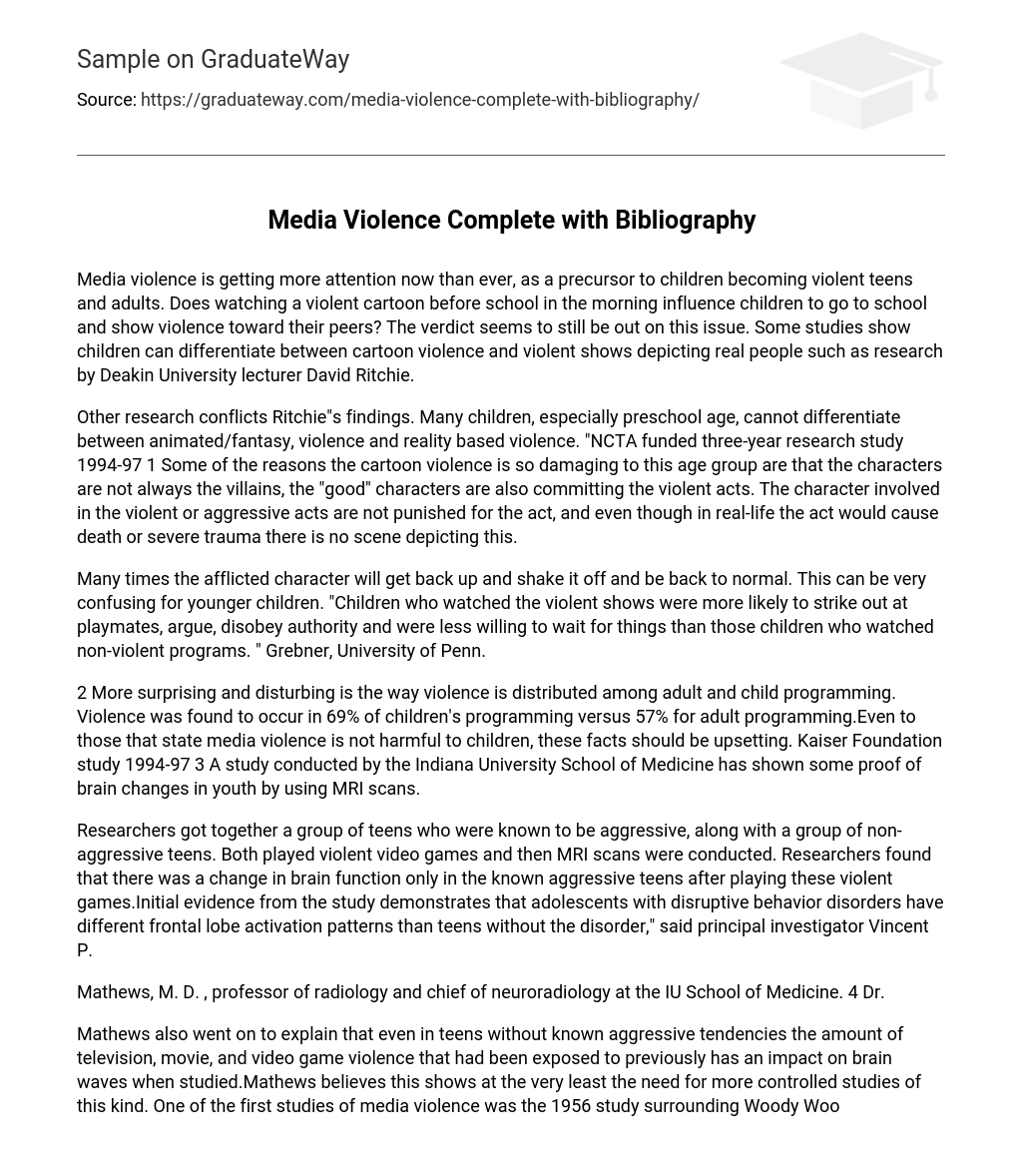Media violence is getting more attention now than ever, as a precursor to children becoming violent teens and adults. Does watching a violent cartoon before school in the morning influence children to go to school and show violence toward their peers? The verdict seems to still be out on this issue. Some studies show children can differentiate between cartoon violence and violent shows depicting real people such as research by Deakin University lecturer David Ritchie.
Other research conflicts Ritchie”s findings. Many children, especially preschool age, cannot differentiate between animated/fantasy, violence and reality based violence. “NCTA funded three-year research study 1994-97 1 Some of the reasons the cartoon violence is so damaging to this age group are that the characters are not always the villains, the “good” characters are also committing the violent acts. The character involved in the violent or aggressive acts are not punished for the act, and even though in real-life the act would cause death or severe trauma there is no scene depicting this.
Many times the afflicted character will get back up and shake it off and be back to normal. This can be very confusing for younger children. “Children who watched the violent shows were more likely to strike out at playmates, argue, disobey authority and were less willing to wait for things than those children who watched non-violent programs. ” Grebner, University of Penn.
2 More surprising and disturbing is the way violence is distributed among adult and child programming. Violence was found to occur in 69% of children’s programming versus 57% for adult programming.Even to those that state media violence is not harmful to children, these facts should be upsetting. Kaiser Foundation study 1994-97 3 A study conducted by the Indiana University School of Medicine has shown some proof of brain changes in youth by using MRI scans.
Researchers got together a group of teens who were known to be aggressive, along with a group of non-aggressive teens. Both played violent video games and then MRI scans were conducted. Researchers found that there was a change in brain function only in the known aggressive teens after playing these violent games.Initial evidence from the study demonstrates that adolescents with disruptive behavior disorders have different frontal lobe activation patterns than teens without the disorder,” said principal investigator Vincent P.
Mathews, M. D. , professor of radiology and chief of neuroradiology at the IU School of Medicine. 4 Dr.
Mathews also went on to explain that even in teens without known aggressive tendencies the amount of television, movie, and video game violence that had been exposed to previously has an impact on brain waves when studied.Mathews believes this shows at the very least the need for more controlled studies of this kind. One of the first studies of media violence was the 1956 study surrounding Woody Woodpecker, half of the 24 children in the study watched a Woody Woodpecker cartoon with violent scenes and the other half watched 1 the non-violent Little Red Hen. After watching the cartoons the children who watched Woody Woodpecker had a greater tendency to hit other children and break objects.
1956, various 5 Another well known and often cited study was performed by Bandura in 1963.Bandura placed half of the children in the study in a room with a violent television program, the other half were playing in a room with no exposure to the show. After Bandura put the children who had watched the show in the same room with those who had, he noticed that those children were much more prone to show aggressiveness than their fellow playmates who did not watch the show. 1963, Bandura 6 After reading many articles and research projects I have come to the conclusion that media violence does affect most children’s tendency to be aggressive.
There are other factors involved, I do not see it as cut and dry as every child who watches a violent show will show violence toward others, but I do believe there is certainly a correlation. I think another hotly debated question comes into play along with exposure to media violence is, are humans naturally violent. Would these same children, had they not been exposed to violence still show aggression in certain circumstances? I believe in some instances they would.I think some of the television programs glamorize violence so much that especially adolescents and young adults tend to think it is the way certain situations are dealt with.
How many shows have we seen that show the bully or the bad guy finally getting beat up by the “good” guy? Even the Brady Bunch showed an episode with Buddy Hinton teasing Cindy and Peter got in a fight to defend her honor. It is 25 years since I saw that episode and I still remember the name of the “bad” character who was only in that one episode.I think it definitely has an impact on the way people deal with confrontations. I would like to see a study done with a group of adolescents and have them watch programs with people verbally dealing with confrontation versus physically for an extended period of time.
They should not be exposed to any violent shows at all. Take the other group and have them watch their regular shows which have depictions of violence and after a year see how these young teens deals with confrontational situations.





